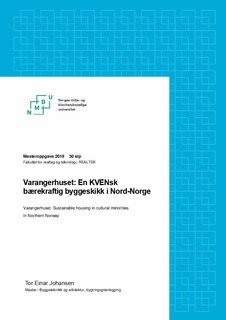| dc.contributor.advisor | Ebert, Martin | |
| dc.contributor.author | Johansen, Tor Einar | |
| dc.coverage.spatial | Norway, Varangerhalvøya | nb_NO |
| dc.date.accessioned | 2019-10-08T13:53:25Z | |
| dc.date.available | 2019-10-08T13:53:25Z | |
| dc.date.issued | 2019 | |
| dc.identifier.uri | http://hdl.handle.net/11250/2620973 | |
| dc.description.abstract | Varangerhuset er en sammenkobling av hus og uthus med aner fra blant annet Russland og Finland. Hustypens historie i Nord-Norge, nærmere bestemt på Varangehavløya, strekker seg i midlertid fra midten av 1800-tallet og frem til dag. De første Varangehusene var tømrede langhus, med oppholdsrom for mennesker i den ene enden og ofte fjøs i den andre.
Hustypen har siden utviklet seg i flere ledd; fra å være et enkelt langhus, til bolig og fjøs parallelt kobletsammen med en gang. Selve fjøsdrift i Varangerhuset opphørte en gang mellom 60 og 70-tallet, og mange av husene som ikke er revet har siden gått over til å bli rene boliger.
Denne måten å samle hus og fjøs på virker å være utviklet på grunn et værhardt klima og begrensinger knyttet til liten materialtilgang langs kysten i Øst-Finnmark. Hustypens historie vitner ellers om en nøktern og pragmatisk tilnærming til bruk av blant annet landareal, energi og materialer.
I dag er fokuset på effektiv utnyttelse av ressursene og bærekraft utvikling sentralt i det fleste næringer og i det meste av politiske aktivitet. Denne oppgaven har studert Varangerhusets historie for å se hvordan byggeskikken kan bidra til en bærekraftig utvikling av Norsk boligutvikling. Oppgavens problemstilling lyder:
«Hvilke sider av byggeskikken knyttet til Varangerhuset var og er bærekraftig,
og hva kan vi lære av den i fremtiden?»
For å svare på problemstillingen undersøkes først ulike aspekter ved bærekraftig boligbygging, samt Varangerhusets historie. Dernest er to Varangerhus studert nøyere, det gjelder Tuomainengården i Vadsø og Berglygården i Hamningberg.
Resultatet viser at hustypen sitter på mange verdifulle kunnskaper som vi kan nyttiggjøre oss av i dag. Blant annet dette med å samle enheter og funksjoner en trenger i hverdagen til ett avgrenset område. På denne måten sparer en ikke bare bygningsmaterialer, men også transport.
Generelt sett ble hustypen bygget; Konsentrert, Varig, Elastisk og Nøktern; som en dyd av nødvendighet. Denne nødvendigheten er fortsatt gyldig, selv om utgangspunkt i dag er litt annerledes. Klodens landareal er endelig og knapphet på materialer og ressurser vil inntreffe dersom forbruket overgår jordens kapasitet. | nb_NO |
| dc.description.abstract | In Varanger, located east in the Norwegian county of Finnmark, there is a building phenomenon called the Varanger farmhouse (Varangerhuset). Its history in the cost of Northern-Norway stretches from the mid-1800s to the day and has roots in both Finland and Russia.
The Varanger farmhouse is a multifunctional house defined by having a residential part in one end and a barn in the other, only separated by an inner hall. The farmhouse is seemingly developed due to a harsh climate and limitations related to building materials and other critical resources. The history of the house shows a frugal and pragmatic approach to the use of land area, energy and materials.
Today, the focus on efficient utilization of resources and sustainability is central in every decision making and political process. This thesis will therefore investigate the history and the development of the Varanger farmhouse, to gain more knowledge about the virtue of restriction and moderation in a sustainability perspective.
The research question of the thesis is formulated like this:
“What aspects of the building tradition associated with the Varanger farmhouse were, and are, sustainable, and what can we learn from it in the future?”
To answer this question, different aspects of sustainable residential building constructions and the history of the Varanger farmhouse are investigated. Furthermore, the Tuomainen farm (Tuomainengården) in Vadsø and the Bergly farm (Berglygården) in Hamningberg are investigated more closely.
The results show that both Tuomainengården and Berglygården, in addition to the Varanger farmhouse as a phenomenon, contains plenty of valuable knowledge which we can use for our benefit today. For example, the practice of gathering houses, barns and other functions one needs in everyday life, in a limited area. With this practice, one is not only able to save on building materials, but also on transportation costs.
The Varanger farmhouse was built – clustered (konsentrert), long-lasting (varig), elastic (elastisk), frugal (nøkternt) - as a virtue of necessity. This necessity is still valid, even though the situation today is a bit different. The land area is a finite resource, and shortages of land area and other critical resources will soon be a fact if consumption over reaches the Earth’s capacity. | nb_NO |
| dc.language.iso | nob | nb_NO |
| dc.publisher | Norwegian University of Life Sciences, Ås | nb_NO |
| dc.rights | Attribution-NonCommercial-NoDerivatives 4.0 Internasjonal | * |
| dc.rights.uri | http://creativecommons.org/licenses/by-nc-nd/4.0/deed.no | * |
| dc.subject | Arkitektur | nb_NO |
| dc.subject | Boliger | nb_NO |
| dc.subject | Bosetting | nb_NO |
| dc.subject | Architecture | nb_NO |
| dc.subject | Settlement | nb_NO |
| dc.title | Varangerhuset : en KVENsk bærekraftig byggeskikk i Nord-Norge | nb_NO |
| dc.title.alternative | Varangerhuset : sustainable housing in cultural minorities in Northern Norway | nb_NO |
| dc.type | Master thesis | nb_NO |
| dc.description.version | submittedVersion | nb_NO |
| dc.subject.nsi | VDP::Teknologi: 500 | nb_NO |
| dc.source.pagenumber | 136 | nb_NO |
| dc.description.localcode | M-BA | nb_NO |

